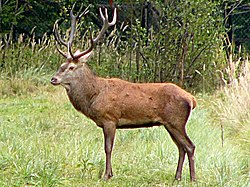| Cervus Temporal range: | |
|---|---|
 | |
| Cervus elaphus | |
| Scientific classification | |
| Kingdom: | Animalia |
| Phylum: | Chordata |
| Class: | Mammalia |
| Order: | Artiodactyla |
| Family: | Cervidae |
| Tribe: | Cervini |
| Genus: | Cervus Linnaeus, 1758 |
| Type species | |
| Cervus elaphus | |
| Species | |
| |
Cervus is a genus of deer that primarily are native to Eurasia, although one species occurs in northern Africa and another in North America. In addition to the species presently placed in this genus, it has included a whole range of other species now commonly placed in other genera. Additionally, the species-level taxonomy is in a state of flux.
